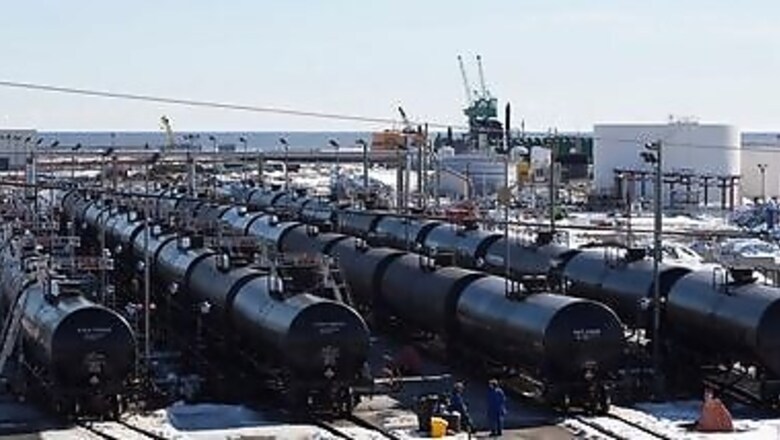
views
WINNIPEG, Manitoba After moving record-large Canadian oil volumes by rail just five months ago, shippers have hit the brakes, idling thousands of cars and tens of millions of dollars’ worth of infrastructure.
Rail was Canada’s oil lifeline in recent years when cheaper pipelines ran full and crude had no other exit from landlocked Alberta. But oil production cuts this year opened pipeline space and eliminated demand for trains, leaving producers like Cenovus Energy Inc with high fixed expenses and monthly payments still owing to railways.
Cenovus said last week it was spending as much as C$20 million ($14.97 million) per month for its suspended rail program, one-quarter of the costs when it is fully active, but now generating no revenue to offset expenses.
Prospects of a longer-term rail recovery also look dim as long-planned pipeline expansions enter service in each of the next two years.
Canadian crude by rail volumes in May fell to 58,048 barrels per day (bpd), the lowest in four years, the Canada Energy Regulator said. In February, they had peaked at nearly 412,000 bpd.
Graphic: https://tmsnrt.rs/3hyqYuW
Cenovus has idled several thousand tank cars, said Chief Executive Alex Pourbaix. He said they will stay parked pending several shifts – rebounding Canadian oil production, pipelines filling again, and a wider gap between Canadian and U.S. crude prices to justify rail shipments’ higher cost than pipelines.
It looks doubtful that will happen soon.
“I wouldn’t be surprised to see (price) differentials widen. (But) I don’t know if they’re going to widen enough in the second half to incent rail,” Pourbaix said in an interview.
Canadian heavy crude in Alberta traded this week for around $10 per barrel below the U.S. benchmark for September delivery, according to NE2 Group, well below the $15-$20 industry estimate for economic rail shipments. Trades for later delivery show the differential widening to just $13 in the fourth quarter.
Even so, Pourbaix expects Canadian oil production to grow to fill expanded pipelines in coming years, reviving the need for rail.
Greater availability of pipeline space has helped keep differentials narrow.
Demand exceeded supply by 7% on two Enbridge Inc heavy oil lines in August, a fraction of the 53% rationing in February that prompted shippers to move a record-large number of barrels by rail.
Investment bank Tudor Pickering Holt & Co forecasts “next to no rail requirements” in Canada into 2021, said analyst Matt Murphy, adding that oil production looks slow to return.
All of that could change suddenly, depending on how quickly pandemic restrictions lift and fuel demand returns, or if there is a significant pipeline outage.
Some are more optimistic.
Suncor Energy Inc Chief Executive Mark Little said last week he expects several operators to ramp up rail shipments this year.
Consultancy Wood Mackenzie also sees rail volumes rising in the second half as production returns.
But large western terminals, owned by Cenovus as well as partnerships between Imperial Oil and Pembina Pipeline Corp , and USD Group and Gibson Energy , have mostly or completely idled, said John Zahary, chief executive of Altex Energy, which loads crude at four Western Canada terminals.
Altex has slowed loadings but not shut any terminals as its shipments remain economic for shippers because they do not require blending with costly lighter oil, he said.
Imperial and Gibson, which report quarterly results soon, declined to comment. Pembina did not respond.
Railways and independent terminals are better insulated from economic damage than oil shippers, as some continue collecting payments, whether they have crude to move or not.
Such payments contracts allow USD to maintain operating capability as markets fluctuate, said Jim Albertson, senior vice president for USD’s Canadian unit.
Canadian National Railway also continues to collect payments, Chief Executive Jean-Jacques Ruest said on a July call.
Disclaimer: This post has been auto-published from an agency feed without any modifications to the text and has not been reviewed by an editor
















Comments
0 comment